Melon’s Puzzle Zoo
Welcome to the Puzzle Zoo run by me, MellowMelon, featuring a large number of unique kinds of puzzles that to the best of my knowledge made their first appearance on this blog, if anywhere. This is a contest hosted by Logic Masters India that will take place on the last weekend of February. Admission to the zoo is free, but you will only have two hours (120 minutes) to tour the place and solve whatever puzzles you can.
The zoo is divided into three sections. The first is Aliens, representing some of my own original puzzle types. The second is Mutants, showcasing some of my variations on familiar Nikoli types. The final is Hybrids, in which each type is a combination of two types, both selected among either Nikoli types or my own original ones. There are four different types of puzzles in each section, for twelve types total.
For each puzzle type in the Alien and Mutant sections, the zoo has two specimens. The first is a baby version, which should prove fairly docile. The second is an adult version. Caution is advised when viewing the adults, as they can be quite aggressive. However, the adult is worth significantly more if successfully solved. The Hybrid section has only adult specimens, with no babies. This means there are 20 puzzles total in the test.
The name of each kind of puzzle, along with the baby and adult point values, are given in the table below. The 8 baby puzzles are worth a total of 250 points, and the 12 adult puzzles are worth a total of 750 points, meaning that 1000 points are available. Ties are broken by time remaining.
| Puzzle Type | Baby | Adult |
|---|---|---|
| Alien 1: Castle Wall | 30 | 60 |
| Alien 2: Out of Sight | 25 | 60 |
| Alien 3: International Borders | 30 | 60 |
| Alien 4: Double Back | 30 | 60 |
| Mutant 1: Akari EX | 30 | 65 |
| Mutant 2: Line Nurikabe | 30 | 60 |
| Mutant 3: Liar Slitherlink | 40 | 70 |
| Mutant 4: Nonconsecutive Fillomino | 35 | 85 |
| Hybrid 1: Castle Wall / Masyu | 50 | |
| Hybrid 2: Yajilin / Akari | 55 | |
| Hybrid 3: Nurikabe / Fillomino | 60 | |
| Hybrid 4: Double Back / Country Road | 65 | |
Credits
- Designed and written by Palmer Mebane (MellowMelon).
- Thanks to Logic Masters India for hosting the competition.
- Thanks to Grant Fikes, Thomas Snyder, and Wei-Hwa Huang for editing and testsolving.
- Thanks to Deb Mohanty and Rakesh Rai for editing the instruction booklet.
- Thanks to David Millar for the baby icon.
Puzzle Instructions
In the instructions below, the word “adjacent” refers to touching in one of the four cardinal directions. Touching at a corner or diagonally is not considered adjacent.
The instructions below completely reproduce the material of the Instruction Booklet that is posted on Logic Masters India. However, it offers a bit more too. One thing is some additional links to the rules pages for each puzzle type as they were originally written when posted on here, which can serve as an additional reference.
More importantly, it links to puzzles of the same type that have been put up on this blog, which can be used as material for practice. Some of these types require thinking quite different from many classic styles, so you are encouraged to take advantage of the opportunity to get familiar with them. The given practice material varies in difficulty, but on the average stays around the level of difficulty the test will have.
In addition to the practice material already provided, to promote the test here I will be posting 12 sample puzzles, one of each type on the test. There will be one every day from this Monday until next Friday, which is shortly before the test can be started. The first piece of practice material listed for each type is a puzzle from this series, although the link will be nonexistent and marked as forthcoming if I haven’t posted the puzzle yet.
Alien 1: Castle Wall
(See also here.)
Draw a single closed loop of horizontal and vertical segments passing through adjacent squares that does not intersect itself. Squares with thick borders represent clues and cannot be part of the loop. If a clue is shaded white, it must be inside the loop. If it is shaded black, it must be outside the loop. Some clues may have a number and arrow. If the arrow points left or right, the number in that cell tells the total length of horizontal segments in the arrow’s direction. Likewise, if there arrow points up or down, the number tells the total length of vertical segments. Equivalently, the number tells how many cell boundaries in the arrow’s direction are crossed by the path. Note that segments counted by arrows do not have to be consecutive, and that the arrow can point past other clue squares – clues don’t block visibility.
Answer Entry: Some squares are marked with letters. For each letter in alphabetical order, determine how many of the nine squares bordering the lettered square, including the square itself, are used in the loop. Enter these digits in alphabetical order by letter.
Example:
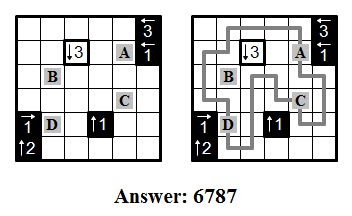
Practice material:
Alien 2: Out of Sight
(See also here. Note that all puzzles of this type posted on this blog are in color, while the test PDF will be in black and white, like the example below.)
Shade in some of the grid squares. No two shaded squares should be adjacent, and all of the unshaded squares should form a single contiguous area – equivalently, any two unshaded squares should have a path joining them through adjacent unshaded squares. Any unshaded arrow should not point to any unshaded cells with a symbol, dot or arrow, of the same color. A shaded arrow need not point to a symbol of the same color. Arrows point past any shaded squares.
Answer Entry: Enter the contents of each cell in the marked rows and columns . Use 0 for an unshaded cell and 1 for a shaded cell.
Example:
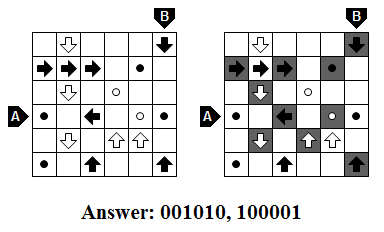
Practice material:
Alien 3: International Borders
(The type as I post it on my blog has been altered for use on the contest. Particularly, shapes instead of colors, and always just two different regions. It would be better to refer to what is written below instead of the description given in my blog.)
Shade in some squares to form a boundary that partitions the grid into two contiguous countries, Circleland and Diamondia. There can be no path through adjacent unshaded squares from one country to the other. Any space with a shape must be unshaded. A circle must be contained in Circleland, and a diamond must be contained in Diamondia. If a space has a square, it is not known which country it is located in. If a shape has a number inside of it, that tells how many of the four adjacent squares are shaded and part of the boundary. All shaded squares must be adjacent to both Circleland and Diamondia, meaning there cannot be any “useless” shaded squares.
Answer Entry: Enter the numbers of grid squares contained in Circleland in each row from top to bottom, separated by commas.
Example:
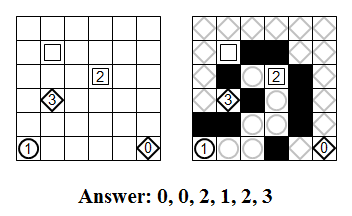
Practice material — all of the puzzles below use just two colors to keep in line with the contest’s version of the type:
Alien 4: Double Back
(See also here. Note that all puzzles of this type posted on this blog are in color, while the test PDF will be in black and white, like the example below. Furthermore, the test will not use black squares like some puzzles here do.)
Draw a single closed loop of horizontal and vertical segments passing through adjacent squares. Every square must be visited exactly once. Each thickly outlined region must be visited exactly twice. Ignore the shading of regions and the letters in some squares for purposes of solving.
Answer Entry: Start from the “A” in the top left corner and move right along the path until you return to the A again. Enter the letters you encounter in order.
Example:

Practice material:
Mutant 1: Akari EX
(See also here. Note that all puzzles of this type posted on this blog have a bit of color, while the test PDF will be in black and white, like the example below.)
This puzzle is based off of Nikoli’s Akari. Place lightbulbs in some cells. Each lightbulb illuminates every square in the four compass directions, similar to a rook in chess, up to the edge of the grid or a black cell. All grid squares must be illuminated, but no two lightbulbs can illuminate each other.
In Akari EX, some walls are triangular, representing mirrors. Light reflects at a 90 degree angle off of these squares and continues on. There is no requirement to illuminate squares with mirrors. Walls with uncircled numbers tell how many of the four adjacent squares contain a lightbulb. Walls with circled numbers tell how many edges of the wall are illuminated by light, whether reflected or not. Light passing through an adjacent square parallel to the wall does not count.
Answer Entry: Enter the digits corresponding to the total number of lightbulbs in each row from top to bottom.
Example:
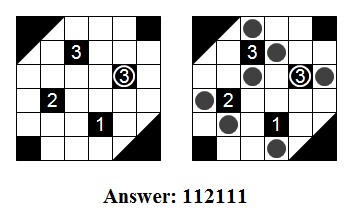
Practice material (Some of these puzzles are the color version; in them the yellow clues correspond to uncircled clues and the green clues correspond to circled ones):
Mutant 2: Line Nurikabe
This puzzle is based off of Nikoli’s Nurikabe. Shade in some of the cells in the grid. All shaded cells must form one contiguous region connected by adjacent squares – shaded squares touching at a corner are not connected. Each connected region of unfilled cells must contain exactly one number, which tells how many cells are in that region.
In Line Nurikabe, it is not allowed to have five consecutive black cells in a row or column. The usual Nurikabe restriction that there can be no two by two squares of black cells does not apply in this puzzle.
Answer Entry: Enter the contents of each cell in the marked rows and columns. Use 0 for an unshaded cell and 1 for a shaded cell.
Example:

Practice material:
Mutant 3: Liar Slitherlink
This puzzle is based off of Nikoli’s Slitherlink. Draw a single closed loop of horizontal and vertical segments passing through adjacent dots that does not intersect itself. A number tells how many of the four adjacent edges of the square are part of the loop. Ignore the letters for the purposes of solving.
In Liar Slitherlink, exactly one number in each row and column is false. You must determine which clues are the liars.
Answer Entry: Some squares are marked with letters. For each letter in alphabetical order, determine how many of the nine squares bordering the lettered square, including the square itself, are contained inside the loop. Enter these digits in alphabetical order by letter.
Example:
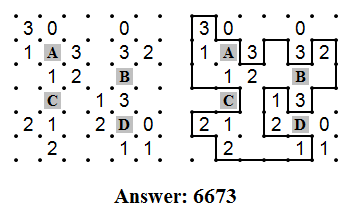
Practice material:
Mutant 4: Nonconsecutive Fillomino
This puzzle is based off of Nikoli’s Fillomino. Fill in each grid cell with a number to partition the grid into polyominoes connected by equal, adjacent numbers. Each number gives the size of the polyomino it is contained in. No two adjacent polyominoes can have the same size. A polyomino can contain any amount of given numbers, including zero.
In Nonconsecutive Fillomino, any two adjacent polyominoes must differ in size by at least two.
Answer Entry: Enter the units digit of each number in the marked rows and columns. For instance, if a 4 or 14 appears in the row or column you would enter 4 for it.
Example:

Practice material:
Hybrid 1: Castle Wall / Masyu
Draw a single closed loop of horizontal and vertical segments passing through adjacent squares that does not intersect itself. Squares with thick borders represent clues and cannot be part of the loop. If a clue is shaded white, it must be inside the loop. If it is shaded black, it must be outside the loop. Some clues may have a number and arrow. If the arrow points left or right, the number in that cell tells the total length of horizontal segments in the arrow’s direction. Likewise, if there arrow points up or down, the number tells the total length of vertical segments. Note that segments counted by arrows do not have to be consecutive, and that the arrow can point past other clue squares – clues don’t block visibility. In addition, the loop must pass straight through any cell with a white circle and turn at one or both of the adjacent squares. The loop must also turn in any cell with a black circle and go straight at both of the adjacent squares.
Answer Entry: Some squares are marked with letters. For each letter in alphabetical order, determine how many of the nine squares bordering the lettered square, including the square itself, are used in the loop. Enter these digits in alphabetical order by letter.
Example:
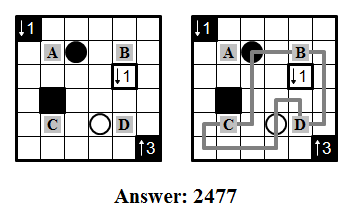
Practice material:
Hybrid 2: Yajilin / Akari
Place lightbulbs in some cells. Each lightbulb illuminates every square in the four compass directions, similar to a rook in chess, up to the edge of the grid or a black cell. All grid squares must be illuminated, but no two lightbulbs can illuminate each other. Then draw a single closed loop of horizontal and vertical segments passing through every square that is not black and does not contain a lightbulb. Some black cells may contain a number and arrow. For these cells, the number tells how many cells in the direction of the arrow are lightbulbs.
Answer Entry: Enter the digits corresponding to the total number of lightbulbs in each row from top to bottom.
Example:
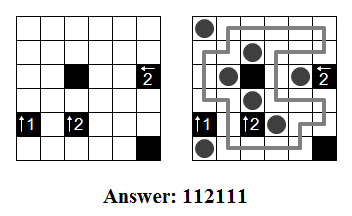
Practice material:
Hybrid 3: Nurikabe / Fillomino
Fill in each grid cell with a number to partition the grid into polyominoes connected by equal, adjacent numbers. Each number gives the size of the polyomino it is contained in. No two adjacent polyominoes can have the same size. No polyomino should contain two or more circled cells. A polyomino can contain any amount of given numbers, including zero. Then fully shade in any polyomino that does not contain a circled cell. All shaded cells must form one contiguous region connected by adjacent squares – shaded squares touching at a corner are not connected. There cannot be any two by two square of shaded cells. No two unshaded polyominoes can be adjacent.
(There’s a lot of details here, so here’s a concise version for those who know both Fillomino and Nurikabe. Find a valid Fillomino solution such that if you then erase every number except those in circles and shade in any polyomino without a circled number, you get a valid Nurikabe solution.)
Answer Entry: Enter the units digit of each number in the marked rows and columns. For instance, if a 4 or 14 appears in the row or column you would enter 4 for it.
Example:
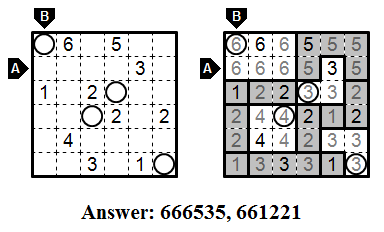
Practice material:
Hybrid 4: Double Back / Country Road
Draw a single closed loop of horizontal and vertical segments passing through adjacent squares in the grid. Each thickly outlined region must be visited exactly twice. For any two adjacent squares not in the same region, at least one must be passed through by the loop. In other words, two adjacent unused squares cannot straddle a region boundary. A number in a cell of a region tells how many cells in that region are passed through by the loop. Ignore the shading of regions and the letters in some squares for purposes of solving.
Answer Entry: Start from the first letter alphabetically that is part of the loop and travel clockwise around the loop until you return to the original letter. Enter the letters you encounter in order. Not all letters may be used.
Example:
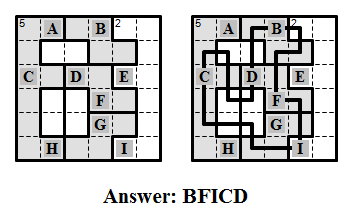
Practice material:
February 14, 2011 at 12:50 am |
I’m looking forward to this. Will you be putting the puzzles up here afterward?
February 14, 2011 at 12:51 am |
That’s possible. I haven’t thought much about what I’ll be doing once the test is over.